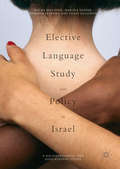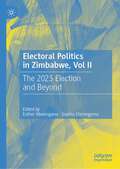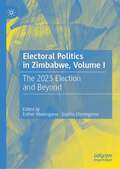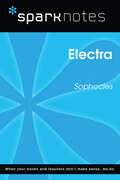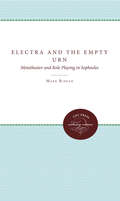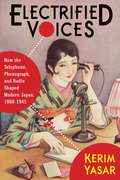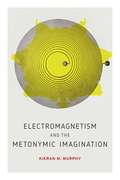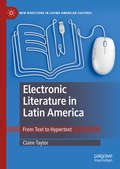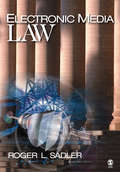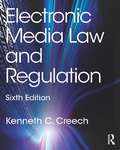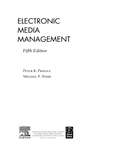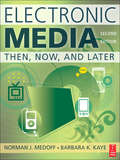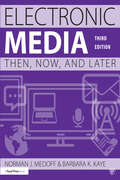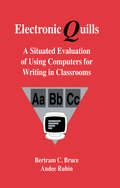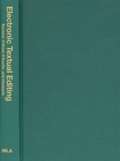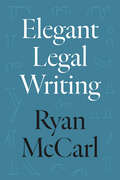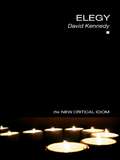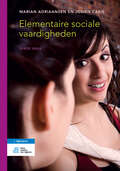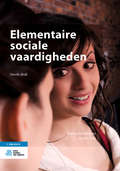- Table View
- List View
Elective Language Study and Policy in Israel
by Malka Muchnik Marina Niznik Anbessa Teferra Tania GluzmanThis book presents research on the instruction of two heritage languages and two foreign languages in Israeli schools. The authors explore language policy and the way languages are studied from the point of view of students, teachers, schools and curricula. Language in Israel is a loaded concept, closely linked to ideological, political, and social issues. The profound changes in language policy in the West along with two large waves of immigration from the Former Soviet Union and Ethiopia resulted in new attitudes towards immigrant languages and cultures in Israel. Are these new attitudes strong enough to change the language policy in the future? What do students and teachers think about the language instruction at school? Are the teaching materials updated and do they address modern demands? This book provides answers to these and other questions. As well as describing the instruction of two heritage languages, Russian and Amharic, and two foreign languages, French and Spanish, the book also contains an extensive background on the immigration history and acculturation process of the speakers of each of these languages. An in-depth understanding of the case of Israel will serve as a guide for other countries contending with similar issues pertaining to the adjustment of language policies in light of immigration and other challenging circumstances.
Electoral Politics in Zimbabwe, Vol II: The 2023 Election and Beyond
by Sophia Chirongoma Esther MavenganoVolume two of Electoral Politics in Zimbabwe: The 2023 Election and Beyond argues that research into Zimbabwe’s politics is multifaceted and topical, particularly because for more than two decades now, this Southern African state has been dogged by multiple problems including hyperinflation, drought, escalating poverty levels, extremely high unemployment rates and political instabilities. The volume’s overall goal is to ignite intellectual discussions and practical action towards turning the political wheels that have been in place for decades. The first segment examines the interface between gender and electoral politics in Zimbabwe. The second part discusses the role of the media in Zimbabwe’s electoral politics. The third section reflects on the role of traditional leaders and religious discourses in Zimbabwe’s electoral politics. The book will be a key resource to colleges, universities and organisations in Zimbabwe, the Southern Africa region and even beyond.
Electoral Politics in Zimbabwe, Volume I: The 2023 Election and Beyond
by Sophia Chirongoma Esther MavenganoVolume one of Electoral Politics in Zimbabwe pays special attention to the overarching view that the 2023 harmonized elections define the fate of the major presidential contenders and their parties as well as (re) shaping the political and economic trajectories of the nation. Cognizant of the complex nature of the Zimbabwean political realm and nuanced dynamics at play, the chapters in this volume cover three interrelated themes: the electoral environment in Zimbabwean politics; language, politics, and elections in Zimbabwe; and lastly, electoral institutions and human rights in Zimbabwean politics. The chapters foreground the ongoing tensions and politicking between the two main rivals, the ruling party, ZANU PF and the main opposition party, the Citizens Coalition for Change (CCC). The contributors also highlight the impact of internal tensions and factionalism within the contending parties, the apparent voter apathy, disconcerting voices due to claims about lack of transparency and a toxic political space as factors impacting on the outcome of the 2023 presidential elections. The volume will appeal to academics and practitioners in politics, human rights, religion, gender, media, languages, linguistics, and development studies.
Electra (SparkNotes Literature Guide Series)
by SparkNotesElectra (SparkNotes Literature Guide) by Sophocles Making the reading experience fun! Created by Harvard students for students everywhere, SparkNotes is a new breed of study guide: smarter, better, faster.Geared to what today's students need to know, SparkNotes provides:chapter-by-chapter analysis explanations of key themes, motifs, and symbols a review quiz and essay topics Lively and accessible, these guides are perfect for late-night studying and writing papers.
Electra and the Empty Urn: Metatheater and Role Playing in Sophocles
by Mark RingerMetatheater, or "theater within theater," is a critical approach often used in studies of Shakespearian or modern drama. Breaking new ground in the study of ancient Greek tragedy, Mark Ringer applies the concept of metatheatricality to the work of Sophocles. His innovative analysis sheds light on Sophocles' technical ingenuity and reveals previously unrecognized facets of fifth-century performative irony. Ringer analyzes the layers of theatrical self-awareness in all sevenSophoclean tragedies, giving special attention to Electra, theplaywright's most metatheatrical work. He focuses on plays within plays,characters who appear to be in rivalry with their playwright in "scripting"their dramas, and the various roles that characters assume in their attempts to deceive other characters or even themselves. Ringer also examines instances of literal role playing, exploring the implications of the Greek convention of sharing multiple roles among only three actors.Sophocles has long been praised as one of the masters of dramaticirony. Awareness of Sophoclean metatheater, Ringer shows, deepens our appreciation of that irony and reveals the playwright's keen awareness of his art.Originally published in 1998.A UNC Press Enduring Edition -- UNC Press Enduring Editions use the latest in digital technology to make available again books from our distinguished backlist that were previously out of print. These editions are published unaltered from the original, and are presented in affordable paperback formats, bringing readers both historical and cultural value.
Electrified Voices: How the Telephone, Phonograph, and Radio Shaped Modern Japan, 1868–1945 (Studies of the Weatherhead East Asian Institute, Columbia University)
by Kerim YasarLong before karaoke’s ubiquity and the rise of global brands such as Sony, Japan was a place where new audio technologies found eager users and contributed to new cultural forms. In Electrified Voices, Kerim Yasar traces the origins of the modern soundscape, showing how the revolutionary nature of sound technology and the rise of a new auditory culture played an essential role in the formation of Japanese modernity.A far-reaching cultural history of the telegraph, telephone, phonograph, radio, and early sound film in Japan, Electrified Voices shows how these technologies reshaped the production of culture. Audio technologies upended the status of the written word as the only source of prestige while revivifying traditional forms of orality. The ability to reproduce and transmit sound, freeing it from the constraints of time and space, had profound consequences on late nineteenth-century language reform; twentieth-century literary, musical, and cinematic practices; the rise of militarism and nationalism in the 1920s and 30s; and the transition to the postwar period inaugurated by Emperor Hirohito’s declaration of unconditional surrender to Allied forces—a declaration that was recorded on a gramophone record and broadcast throughout the defeated Japanese empire. The first cultural history in English of auditory technologies in modern Japan, Electrified Voices enriches our understanding of Japanese modernity and offers a major contribution to sound studies and global media history.
Electromagnetism and the Metonymic Imagination (AnthropoScene #4)
by Kieran M. MurphyHow does the imagination work? How can it lead to both reverie and scientific insight? In this book, Kieran M. Murphy sheds new light on these perennial questions by showing how they have been closely tied to the history of electromagnetism.The discovery in 1820 of a mysterious relationship between electricity and magnetism led not only to technological inventions—such as the dynamo and telegraph, which ushered in the “electric age”—but also to a profound reconceptualization of nature and the role the imagination plays in it. From the literary experiments of Edgar Allan Poe, Honoré de Balzac, Villiers de l’Isle-Adam, and André Breton to the creative leaps of Michael Faraday and Albert Einstein, Murphy illuminates how electromagnetism legitimized imaginative modes of reasoning based on a more acute sense of interconnection and a renewed interest in how metonymic relations could reveal the order of things.Murphy organizes his study around real and imagined electromagnetic devices, ranging from Faraday’s world-changing induction experiment to new types of chains and automata, in order to demonstrate how they provided a material foundation for rethinking the nature of difference and relation in physical and metaphysical explorations of the world, human relationships, language, and binaries such as life and death. This overlooked exchange between science and literature brings a fresh perspective to the critical debates that shaped the nineteenth century.Extensively researched and convincingly argued, this pathbreaking book addresses a significant lacuna in modern literary criticism and deepens our understanding of both the history of literature and the history of scientific thinking.
Electromagnetism and the Metonymic Imagination (AnthropoScene: The SLSA Book Series #4)
by Kieran M. MurphyHow does the imagination work? How can it lead to both reverie and scientific insight? In this book, Kieran M. Murphy sheds new light on these perennial questions by showing how they have been closely tied to the history of electromagnetism.The discovery in 1820 of a mysterious relationship between electricity and magnetism led not only to technological inventions—such as the dynamo and telegraph, which ushered in the "electric age"—but also to a profound reconceptualization of nature and the role the imagination plays in it. From the literary experiments of Edgar Allan Poe, Honoré de Balzac, Villiers de l’Isle-Adam, and André Breton to the creative leaps of Michael Faraday and Albert Einstein, Murphy illuminates how electromagnetism legitimized imaginative modes of reasoning based on a more acute sense of interconnection and a renewed interest in how metonymic relations could reveal the order of things.Murphy organizes his study around real and imagined electromagnetic devices, ranging from Faraday’s world-changing induction experiment to new types of chains and automata, in order to demonstrate how they provided a material foundation for rethinking the nature of difference and relation in physical and metaphysical explorations of the world, human relationships, language, and binaries such as life and death. This overlooked exchange between science and literature brings a fresh perspective to the critical debates that shaped the nineteenth century.Extensively researched and convincingly argued, this pathbreaking book addresses a significant lacuna in modern literary criticism and deepens our understanding of both the history of literature and the history of scientific thinking.
Electronic Literacies: Language, Culture, and Power in Online Education
by Mark WarschauerElectronic Literacies is an insightful study of the challenges and contradictions that arise as culturally and linguistically diverse learners engage in new language and literacy practices in online environments. The role of the Internet in changing literacy and education has been a topic of much speculation, but very little concrete research. This book is one of the first attempts to document the role of the Internet and other new digital technologies in the development of language and literacy. Warschauer looks at how the nature of reading and writing is changing, and how those changes are being addressed in the classroom. His focus is on the experiences of culturally and linguistically diverse learners who are at special risk of being marginalized from the information society. Based on a two-year ethnographic study of the uses of the Internet in four language and writing classrooms in the state of Hawai'i--a Hawaiian language class of Native Hawaiian students seeking to revitalize their language and culture; an ESL class of students from Pacific Island and Latin American countries; an ESL class of students from Asian countries; and an English composition class of working-class students from diverse ethnic backgrounds--the book includes data from interviews with students and teachers, classroom observations, and analysis of student texts. This rich ethnographic data is combined with theories from a broad range of disciplines to develop conclusions about the relationship of technology to language, literacy, education, and culture. Central to Warschauer's discussion and conclusions is how contradictions of language, culture, and class affect the impact of Internet-based education. While Hawai'i is a special place, the issues confronted here are similar in many ways to those that exist throughout the United States and many other countries: How to provide culturally and linguistically diverse students traditionally on the educational and technological margins with the literacies they need to fully participate in public, community, and economic life in the 21st century.
Electronic Literature in Latin America: From Text to Hypertext (New Directions in Latino American Cultures)
by Claire TaylorThis book explores one of the most exciting new developments in the literary field to emerge over recent decades: the growing body of work known as ‘electronic literature’, comprising literary works that take advantage of the capabilities of digital technologies in their enactment. Focussing on six leading authors within Latin(o) America whose works have proved pioneering in the development of these new literary forms, the book proposes a three-fold approach of aesthetics, technologics, and ethics, as a framework for analyzing digital literature.
Electronic Media Law
by Dr Roger L. SadlerElectronic Media Law is written for mass media students, not for future lawyers, so the text is straightforward and explains "legalese." The author covers First Amendment law, political broadcasting rules, broadcast content regulations, FCC rules for station operations, cable regulation, media ownership rules, media liability lawsuits, intrusive newsgathering methods, media restrictions during wartime, libel, privacy, copyright, advertising law, freedom of information, cameras in the court, and privilege.
Electronic Media Law and Regulation
by Kenneth C. CreechElectronic Media Law and Regulation is a case-based law text that provides students with direct access to case law as well as the context in which to understand its meaning and impact. The text overviews the major legal and regulatory issues facing broadcasting, cable, and developing media in today's industry. Presenting information from major cases, rules, regulations, and legal documents in a concise and readable form, this book helps current and prospective media professsionals understand the complex realm of law and regulation. Students will learn how to avoid common legal pitfalls and anticipate situations that may have potential legal consequences. This sixth edition provides annotated cases with margin notes, and new chapters address such timely issues as media ownership, freedom of information, entertainment rights, and cyber law.
Electronic Media Management, Revised
by Peter Pringle Michael F StarrThe fifth edition of a classic text features important updates that reflect the enormous changes that have taken place in recent years - the Internet as an important information transmission format that is here to stay and convergence among media. This edition features thorough discussions on the Internet and convergence, as well as reflects the latest information on broadcast and cable regulations and policies. It also includes a fresh batch of case studies, and study questions. As in previous editions, this book also covers management theory, audience analysis, broadcast promotion, and marketing.
Electronic Media: Then, Now, and Later
by Barbara Kaye Norman J. MedoffElectronic Media connects the traditional world of broadcasting with the contemporary universe of digital electronic media. It provides a synopsis of the beginnings of electronic media in broadcasting, and the subsequent advancements into digital media. Underlying the structure of the book is a "See It Then, See It Now, See It Later? approach that focuses on how past innovations lay the groundwork for changing trends in technology, providing the opportunity and demand for change in both broadcasting and digital media. FYI and Zoom-In boxes point to further information, tying together the immediate and long-ranging issues surrounding electronic media. Career Tracks feature the experiences of industry experts and share tips in how to approach this challenging industry. Check out the companion website at http://www.routledge.com/cw/medoff-9780240812564/ for materials for both students and instructors.
Electronic Media: Then, Now, and Later
by Barbara Kaye Norman J. MedoffElectronic Media: Then, Now, and Later provides a synopsis of the beginnings of electronic media in broadcasting and the subsequent advancements into digital media. The Then, Now, and Later approach focuses on how past innovations laid the groundwork for changing trends in technology, providing the opportunity and demand for evolution in both broadcasting and digital media. An updated companion website provides links to additional resources, chapter summaries, study guides and practice quizzes, instructor materials, and more. This new edition features two new chapters: one on social media, and one on choosing your entertainment and information experience. The then/now/later thematic structure of the book helps instructors draw parallels (and contracts) between media history and current events, which helps get students more engaged with the material. The book is known for its clear, concise, readable, and engaging writing style, which students and instructors alike appreciate. The companion website is updated and offers materials for instructors (an IM, PowerPoint slides, and test bank)
Electronic Quills: A Situated Evaluation of Using Computers for Writing in Classrooms (Technology and Education Series)
by Bertram C. Bruce Andee Rubin with contributi Barnhardt and TeachersThis volume centers on the words and experiences of teachers and students who used QUILL -- a software package developed by the authors to aid in writing instruction. It looks in detail at the stories of these early users and considers questions relevant for other teachers, students, researchers, and developers of educational innovations. Questions posed include: * What does it mean to develop an environment for literacy in an actual classroom? * How can a teacher create an environment in which students work together toward meaningful goals? * How can a teacher promote the rich communication so necessary for developing language? * What is the role of technology in the practice and development of literacy? The examination of the QUILL experiences provides a fuller and more revealing account of what it meant to use QUILL than would have been possible through standard evaluation techniques. At the same time, the focus on the particulars also finds analogues in analyses of similar pieces of open-ended software or educational innovations in general.
Electronic Textual Editing
by John Unsworth Lou Burnard Katherine O'Brien O'KeeffeAlthough the contributors come from diverse disciplines and institutions around the world, this collection reflects an emerging consensus about the fundamental issues of electronic textual editing. The 24 essays address markup coding and procedures, electronic archive administration, use of standards, rights and permissions, and the changing environment of the internet. The guidelines of the Modern Language Association for scholarly editions are included in full.
Electronic Tools for Translators (Translation Practices Explained)
by Frank AustermuhlElectronic Tools for Translators offers complete explanations of a wide range of software products, information resources and online services that translators now need to understand and use. Individual chapters run through the origins and nature of the internet, the many ways of searching for information, and translation resources on the web, CD-ROMs as information sources, computer-assisted terminology management, the use and construction of corpora, translation memories, localization tools, and the incorporation of machine translation programmes into the translation process. Austermühl explains all these tools and resources in a clear, step-by-step way, suggesting learning tasks and activities for each chapter and guiding the reader through the jargon. Examples are drawn from English, French, German and Spanish. The book can be used as a text in regular classes on computer-assisted translation, in translation practice classes, as well as for self-learning by professionals wishing to update their skills.
Elegant Jeremiahs: The Sage from Carlyle to Mailer (Routledge Revivals)
by George P. LandowLabelled "an elegant Jeremiah" by a journalist of his day, the urbane Victorian Matthew Arnold must have received the comparison with the Old Testament prophet uneasily. Writing in the 1970s, Norman Mailer seems to owe nothing to the biblical for his description of a long hot wait to buy a cold drink while reporting on the first voyage to the moon. Yet both Arnold and Mailer, George P. Landow asserts in this book, are sages, writers in the nonfiction prose form of secular prophecy, a genre richly influenced by the episodic structures and harshly critical attitudes toward society which characterize Old Testament prophetic literature. In this book, first published in 1986, Landow defines the genre by exploring its rhetoric, an approach that enables him to illuminate the relationships among representative works of the nineteenth century to one another, to biblical, oratorical, and homiletic traditions, and to such twentieth-century writers as Lawrence, Didion, and Mailer.
Elegant Legal Writing
by Ryan McCarlElegant Legal Writing helps attorneys elevate their writing from passable to polished. Drawing on ideas from cognitive science, stylistics, and litigation strategy, the book teaches practical techniques by example using fast-paced chapters. Readers will learn the essentials of effective legal composition: Writing clear, efficient prose Crafting strong arguments Telling a client's story through a compelling narrative Overcoming procrastination and drafting more productively Readability, aesthetics, and argumentation are intertwined. Ryan McCarl shows how litigation documents that are easier and more pleasant to read are more likely to persuade judges and other busy readers. The book also discusses parts of legal writing that many guides overlook, including sentence mechanics, writing technology, and typography.
Elegant Nightmares: The English Ghost Story from Le Fanu to Blackwood
by Jack SullivanLiterary criticism of early twentieth-century ghost stories and supernatural fiction; these are the writers who influenced H. P. Lovecraft and who helped create horror and dark fantasy as we know it today.
Elegy: Poetry, Elegy, Walking, Spirit (The New Critical Idiom)
by David KennedyGrief and mourning are generally considered to be private, yet universal instincts. But in a media age of televised funerals and visible bereavement, elegies are increasingly significant and open to public scrutiny. Providing an overview of the history of the term and the different ways in which it is used, David Kennedy: outlines the origins of elegy, and the characteristics of the genre examines the psychology and cultural background underlying works of mourning explores how the modern elegy has evolved, and how it differs from ‘canonical elegy’, also looking at female elegists and feminist readings considers the elegy in the light of writing by theorists such as Jacques Derrida and Catherine Waldby looks at the elegy in contemporary writing, and particularly at how it has emerged and been adapted as a response to terrorist attacks such as 9/11. Emphasising and explaining the significance of elegy today, this illuminating guide to an emotive literary genre will be of interest to students of literature, media and culture.
Elementaire sociale vaardigheden: Transferpunt Vaardigheidsonderwijs
by Marian Adriaansen Josien CarisCommuniceren is een belangrijk onderdeel van vrijwel elk beroep. Of communicatieprocessen effectief verlopen is niet alleen afhankelijk van aan te leren technieken, maar vooral ook van de 'echtheid' van iemands optreden. Om effectief te kunnen communiceren heb je (zelf)kennis nodig over je eigen kwaliteiten. Dit leermateriaal helpt je om de basisvaardigheden zo aan te leren dat zij kunnen dienen als solide basis voor de ontwikkeling van je specifieke beroepsvaardigheden. De auteurs besteden in de hoofdstukken op oriënterend niveau ook aandacht aan de toepassing van de basisvaardigheden in verschillende hulpverleningssituaties binnen welzijn en gezondheidszorg. Nieuw is de website met daarop een serie filmfragmenten waarin de besproken vaardigheden worden gedemonstreerd. Op deze website zijn ook toetsvragen, studieopdrachten en oefeningen opgenomen, die een actieve wijze van kennismaken met en oefenen van de beoogde vaardigheden mogelijk maken. Aan deze geheel herziene druk zijn twee nieuwe hoofdstukken toegevoegd: Argumenteren en Digitaal communiceren. Waar vele boeken vooral ingaan op de theorie, is dit boek ook erg praktijkgericht. Het geeft studenten goede handvatten om theorie toe te passen en te oefenen, waardoor het boek meer is dan alleen een verdiepend boek.
Elementaire sociale vaardigheden: Transferpunt Vaardigheidsonderwijs
by Marian Adriaansen Josien CarisDit boek helpt studenten in zorg en welzijn om communicatieve basisvaardigheden zó aan te leren dat die een solide basis vormen voor de ontwikkeling van specifieke beroepsvaardigheden. Ook leren ze om die communicatieve vaardigheden in verschillende hulpverleningssituaties toe te passen. Daarbij heeft het boek aandacht voor aan te leren technieken, én voor de echtheid van iemands optreden. Effectief communiceren vereist immers ook kennis over je eigen kwaliteiten. Elementaire sociale vaardigheden gaat uitgebreid in op de theorie, én is erg praktijkgericht. Het s een verdiepend boek, dat studenten handvatten geeft om theorie te oefenen en toe te passen. Aan deze geheel herziene druk is bovendien een nieuw hoofdstuk toegevoegd: omgaan met laaggeletterdheid. Ook nieuw is de mogelijkheid om met behulp van een app direct vanuit het boek de bijpassende filmfragmenten te bekijken. In deze filmfragmenten worden de besproken vaardigheden gedemonstreerd. Ze staan ook op mijn.bsl.nl - net als de toetsvragen, studieopdrachten en oefeningen. Zo kun je eenvoudig kennismaken met de beoogde vaardigheden, en ze actief oefenen.
